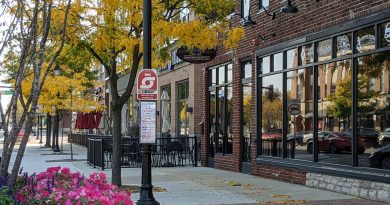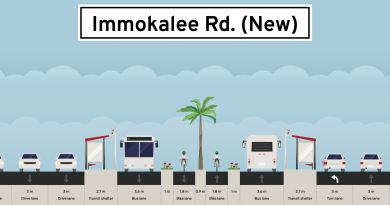Making Michigan Transit Work: Coming Soon, or a Pipe Dream?

Detroit has a reputation of being pretty weak on public transit, and it’s not undeserved. Southeast Michigan in general is, predictably, heavily dependent upon automobiles, with fixtures like the peculiar Michigan Left dominating inexplicably expansive thoroughfares that traverse sparsely populated suburban areas and the barely-denser city of Detroit alike. A dysfunctional regional transit system in metro Detroit is plagued by the ability of municipalities to opt out of funding and participation. Put all together, the systems just don’t work right, as evidenced by the Detroit Walking Man sob story, or by, well, living here.
Michigan is currently embroiled in a debate over how to fix pothole-plagued roads, currently through a proposed 15-cent gas tax hike that looks like it will pass in spite of the fact that it cuts the state Earned Income Tax Credit to working poor families and penalizes fuel-efficient car owners. The new proposal requires the state to reallocate $700 million in current revenue exclusively toward road repair and construction. The state has failed to take into account some revenue-producing option that would either 1) index the gas tax to inflation, 2) include a vehicle miles traveled (VMT) tax as an alternative or a supplement (imperfect though that may be), or 3) fund any sort of public transit in addition to the hundreds of millions to be spent on highways. This follows the failure of Proposition 1, which would have more equitably redistributed funds but still provided no support for public transit infrastructure.
But alternatives are coming, and they might not all garner the same ridicule that locals often hurl at the M-1 Woodward rail line, which I’ve heard on more than a few occasions referred to as the “train to nowhere.” A 3.3 mile light rail line along Woodward, the line will make intermodal connections along one of the busiest urban street routes within the most densely populated urban core of a metro area of 4.2 million. Somehow, standing in the middle of Campus Martius, I’m not entirely sure how the surrounding office towers constitute “nowhere,” but I’m sure someone has thought up a clever answer. While the original plan was to extend the line to 8 Mile, the current, shortened line terminates in New Center, home of Shinola, the College for Creative Studies, and a coming tsunami of gentrification. It is unclear whether the line will ever be extended (Woodward goes the whole way to the metropolis of Pontiac through the likes of Ferndale, Royal Oak, Birmingham, and Bloomfield Hills, but no one can agree on money and proponents think that the federal government would have to kick in beaucoup bucks for it), but meanwhile, many have their doubts, with a generation-long public transit drought in the Motor City.

The urbanist snark echo chamber has their own feelings about light rail, crying that they’re not economical enough, that BRT is cheaper, and that we should privatize the entire universe because obviously Uber will fix everything and because #markets. There are benefits to either BRT or LRT, but there doesn’t seem to be consensus about the best long-term option.
The interesting and less-discussed options in the works are improvements to the Amtrak route as well as the proposed SEMCOG and WALLY routes. Amtrak trains chug along at a leisurely pace between Detroit and Ann Arbor, taking about an hour to travel thirty-some miles, even though the railroad began upgrading the tracks in 2013 in a process that still appears to be ongoing but has reduced the travel time substantially from what used to be close to seven hours for a 200-some mile trip (speeds are up to 115 mph on some sections). Speeds between Michigan City and roughly Ann Arbor are actually pretty fast, but the disaster of Chicago’s rail network slows down the approach to the city and won’t be fixed any time soon.
WALLY, the Washtenaw-Livingston line, is a proposed 27-mile route between Howell and Ann Arbor intended to ease congestion on US-23, which I frequently find myself driving during rush hour (it isn’t pretty). And the Ann Arbor to Detroit route proposed by SEMCOG joins WALLY in proposals that have languished for years since people decided they might actually be a solid idea. It’s unfortunately clear that, especially given recent cuts by Congressional Republicans, Amtrak simply doesn’t have the funding to add their own trains, even though this would prevent the duplication of an existing, though slow, route. SEMCOG’s own efforts for MITrain are hampered by the fact that the rail network is owned by profitable freight railroads who don’t have a track record of playing well with passenger transit (and whose idea of “intermodal” is “shipping containers delivered efficiently through expensive infrastructure“), so the project remains up in the air in spite of the fact that they’ve acquired, refurbished, and tested rail cars on the route.
Slow though it may be, it looks like Detroit is adapting to a more modern paradigm after a generation of exclusively car-dominated transit infrastructure. “They think that monorail is gonna change the neighborhood,” my mechanic in Milwaukee Junction said to me this morning, shaking his head after replacing my rear shocks, well-worn from a disastrous affair with Rust Belt street grids. “I guess we’ll find out.” Meanwhile, the Detroit News reports that a Detroit to Grand Rapids line like the original Pere Marquette could be reinstated… some time in the next ten years. Fingers crossed that it won’t take that long.



